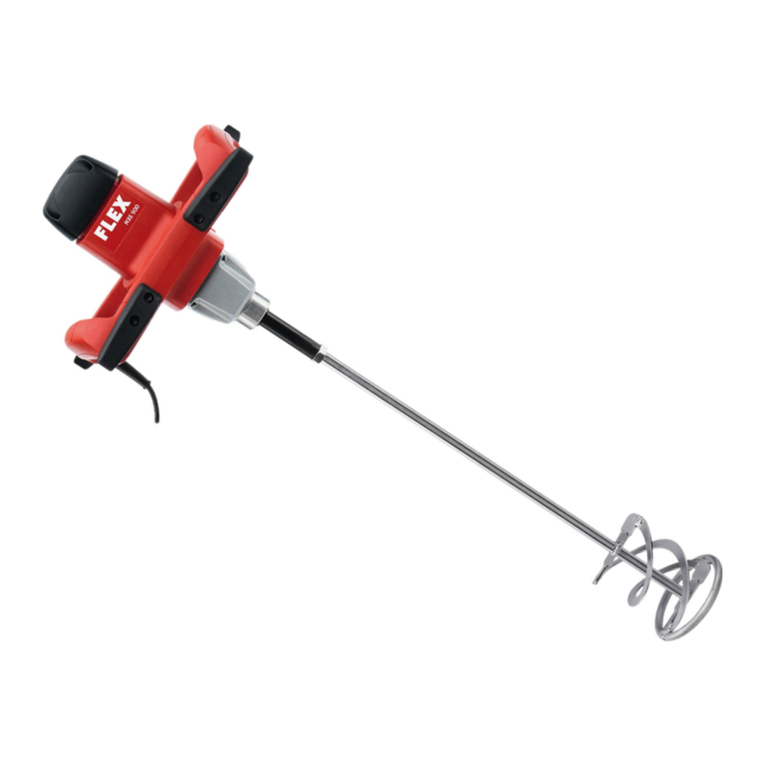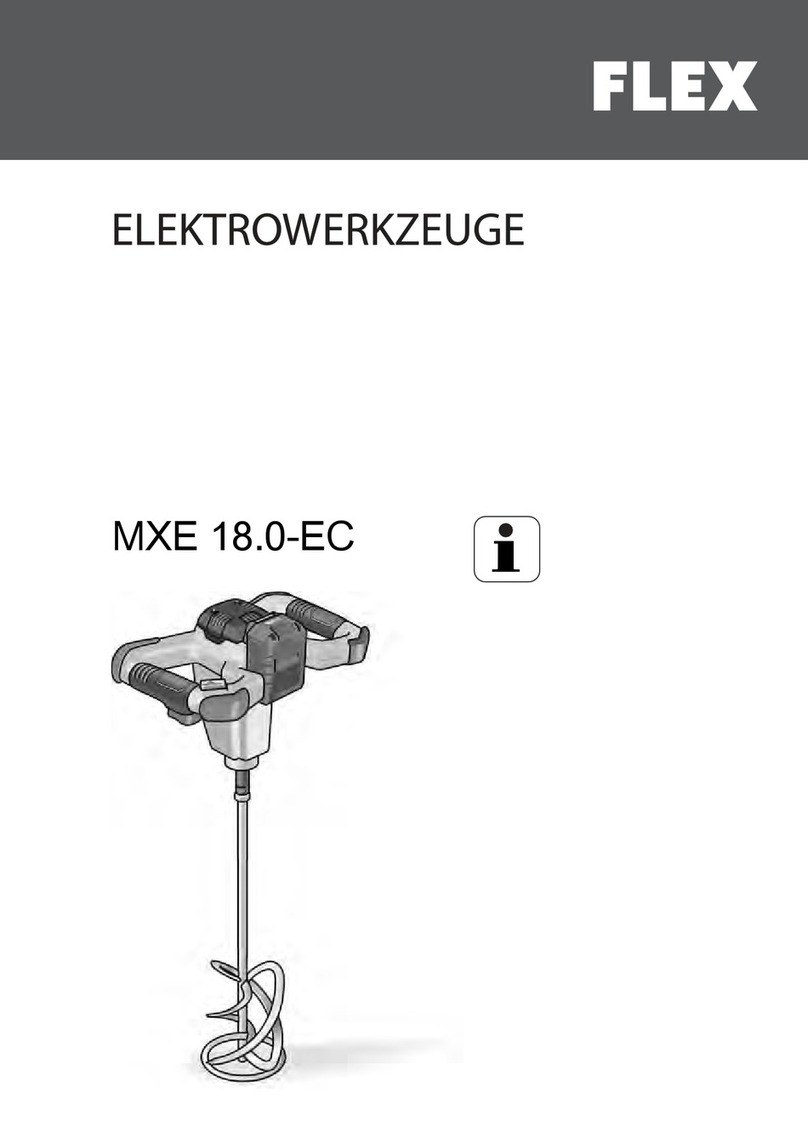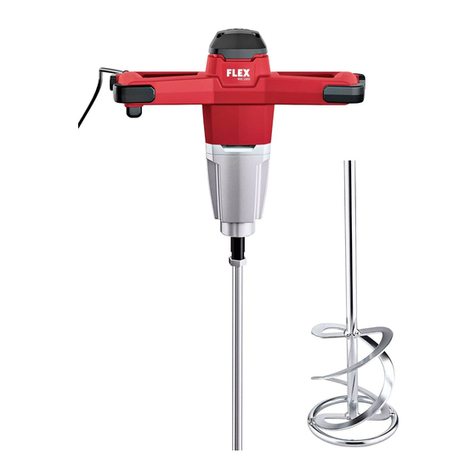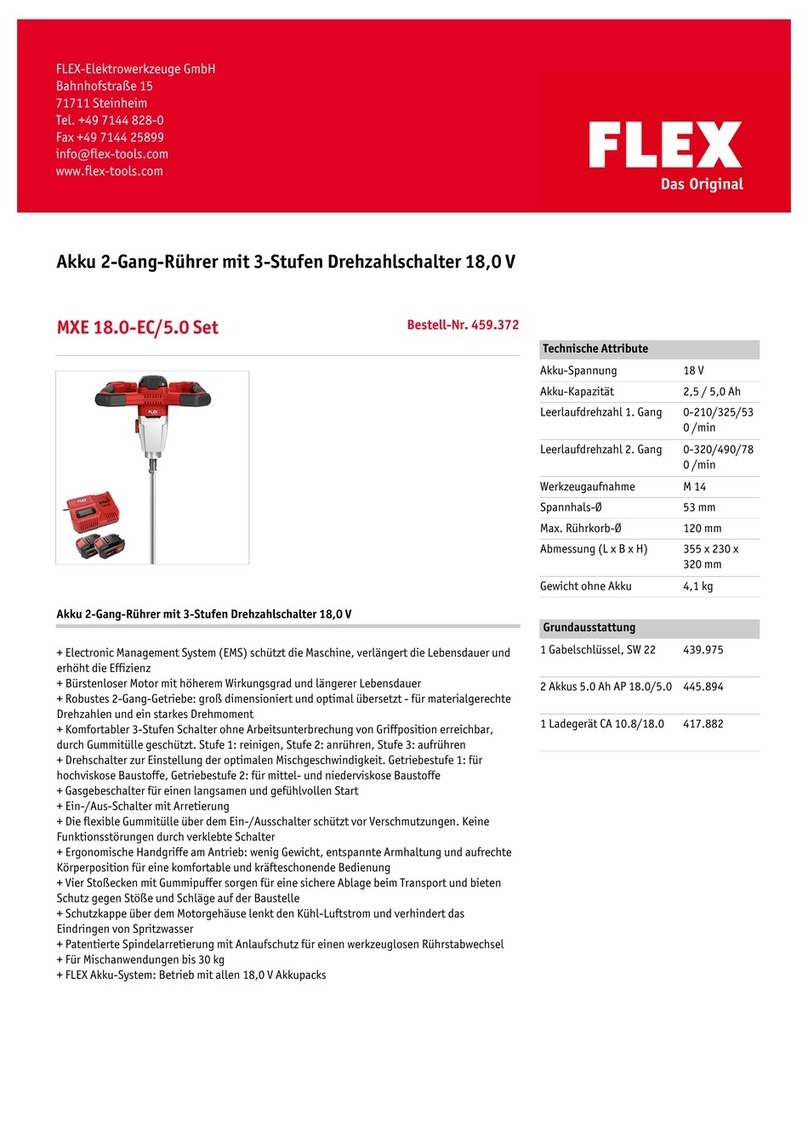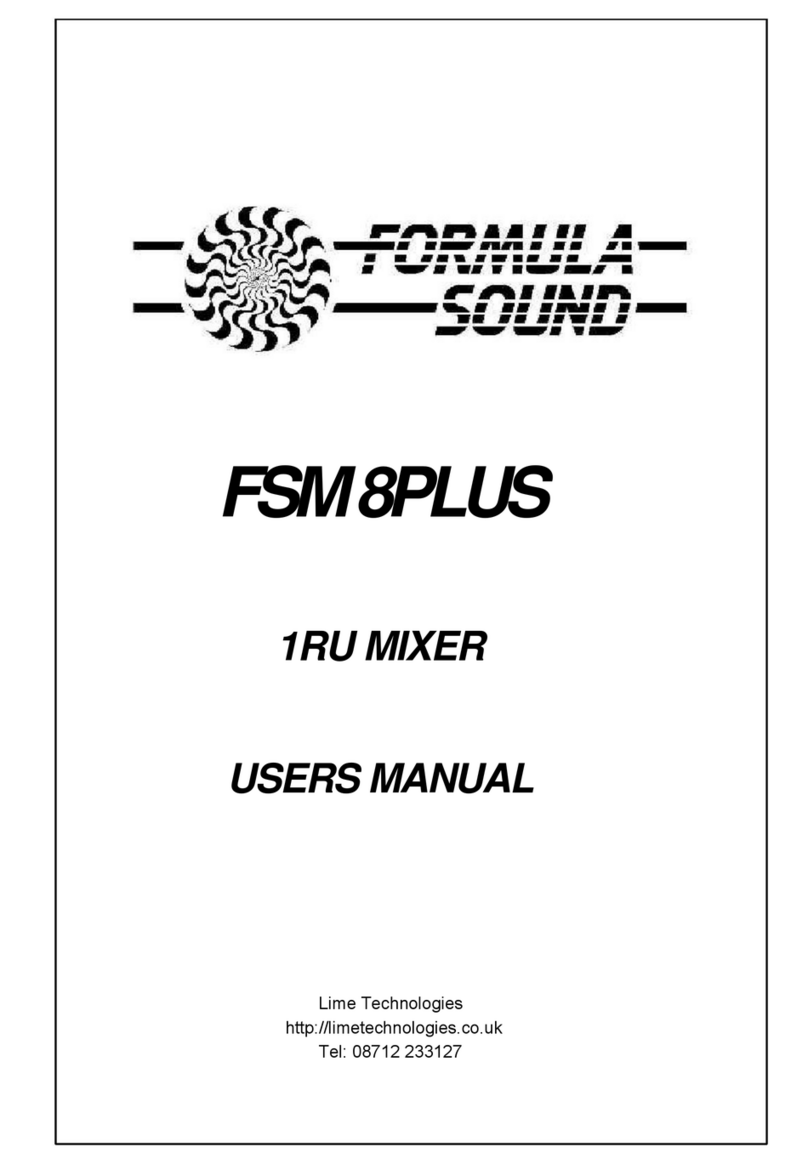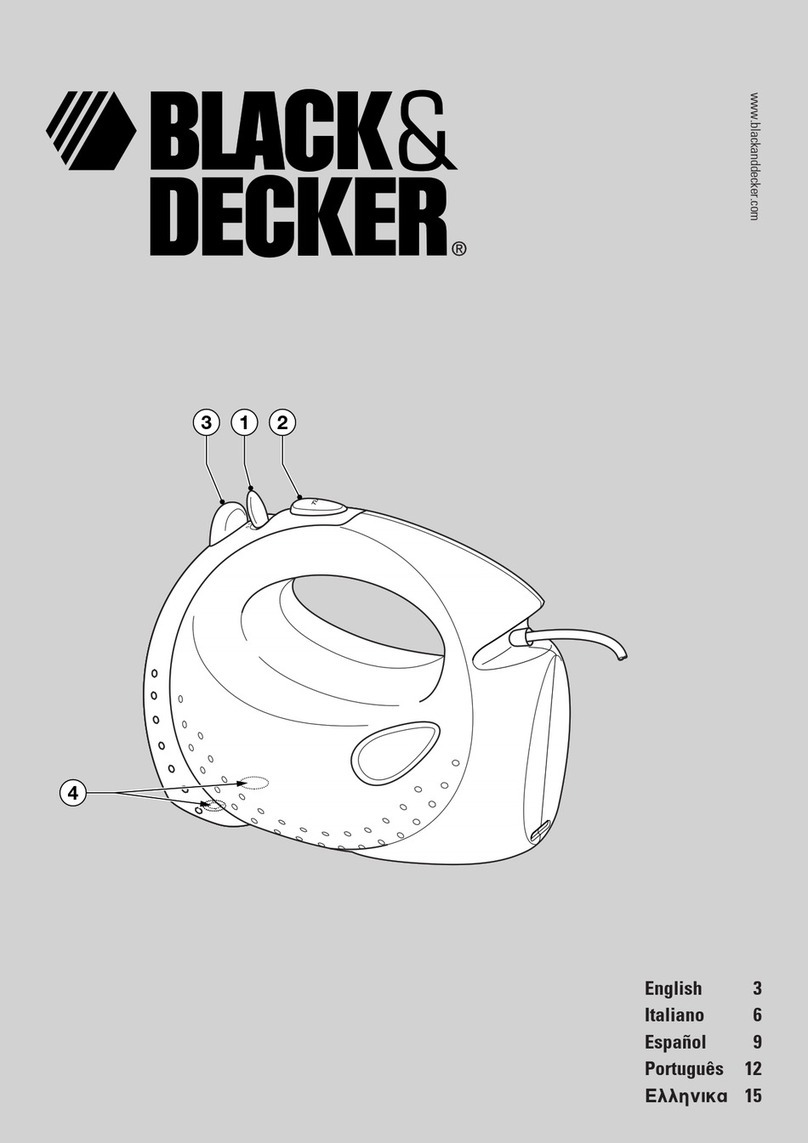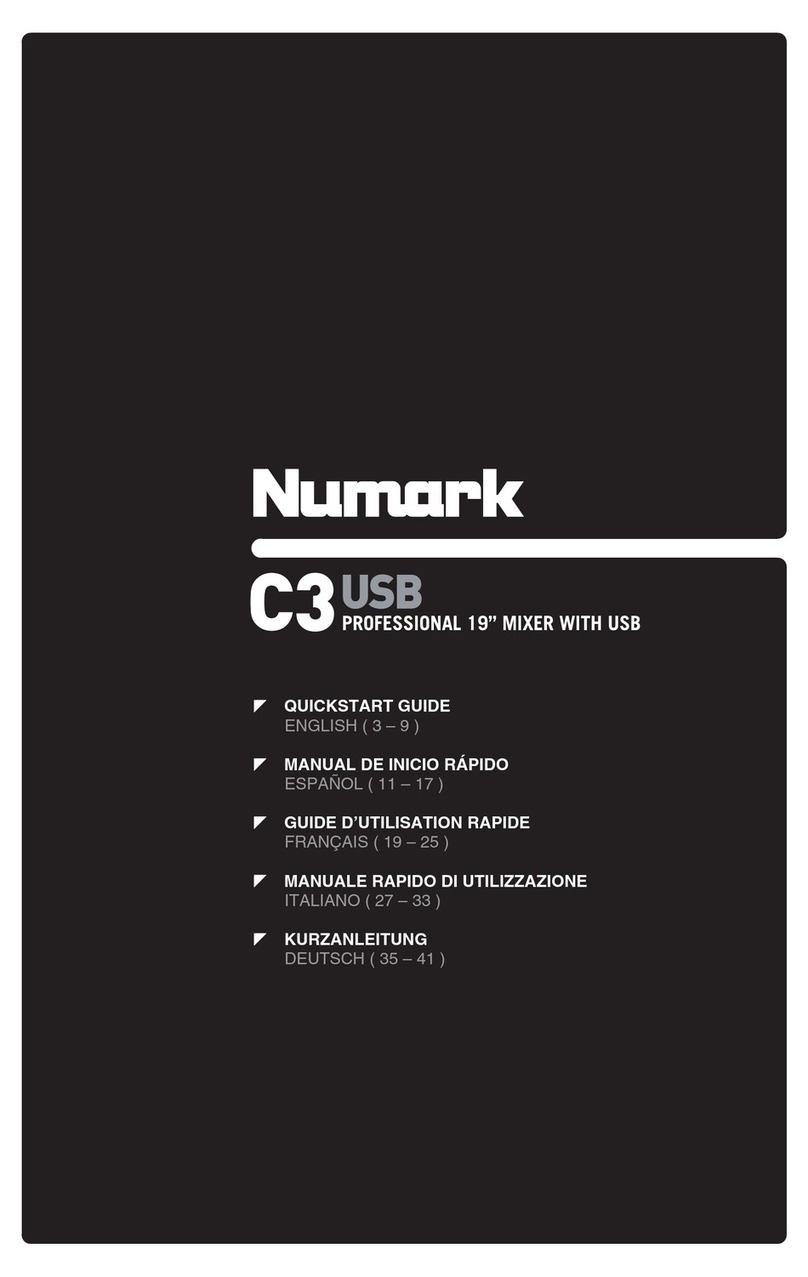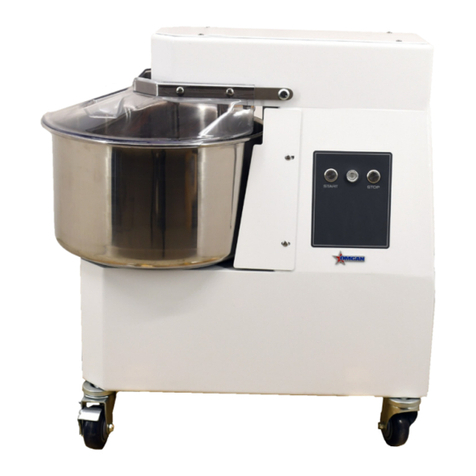Flex FX6151 User manual

Model:
Modelo:
Modèle:
OPERATOR’S MANUAL
MANUAL DEL OPERADOR
MANUEL DE L’UTILISATEUR
833-FLEX-496
(833-3539-496)
For English
Version
See page 2
◆
Version
française
Voir page 16
◆
Versión en
español
Ver la página 31
www.Registermyex.com
Contact Us /
Nous contacter /
Contáctenos
24V MIXER
MÉLANGEUR DE 24 V
MEZCLADORA DE 24 V
FX6151

-2-
SAFETY SYMBOLS
The purpose of safety symbols is to attract your attention to possible dangers. The safety symbols
and the explanations with them deserve your careful attention and understanding. The symbol
warnings do not, by themselves, eliminate any danger. The instructions and warnings they give are
no substitutes for proper accident prevention measures.
WARNING Be sure to read and understand all safety instructions in this Owner's Manual,
including all safety alert symbols such as “DANGER,” “WARNING,” and
“CAUTION” before using this tool. Failure to follow all instructions listed below may result in electric
shock, re, and/or serious personal injury.
The denitions below describe the level of severity for each signal word. Please read the manual and
pay attention to these symbols.
This is the safety alert symbol. It is used to alert you to potential personal
injury hazards. Obey all safety messages that follow this symbol to avoid
possible injury or death.
DANGER DANGER indicates a hazardous situation which, if not avoided, will result in
death or serious injury.
WARNING WARNING indicates a hazardous situation which, if not avoided, could result
in death or serious injury.
CAUTION CAUTION, used with the safety alert symbol, indicates a hazardous situation
which, if not avoided, will result in minor or moderate injury.
Damage Prevention and Information Messages
These inform the user of important information and/or instructions that could lead to equipment or
other property damage if they are not followed. Each message is preceded by the word “NOTICE”,
as in the example below:
NOTICE: Equipment and/or property damage may result if these instructions are not followed.
WARNING The operation of any power tools can result in foreign
objects being thrown into your eyes, which can result in
severe eye damage. Before beginning power tool operation, always wear
safety goggles or safety glasses with side shields and a full face shield when
needed. We recommend a Wide Vision Safety Mask for use over eyeglasses
or standard safety glasses with side shields. Always use eye protection which
is marked to comply with ANSI Z87.1.

-3-
GENERAL POWER TOOL SAFETY WARNINGS
WARNING Read all safety warnings, instructions, illustrations and specications
provided with this power tool. Failure to follow all instructions listed below may
result in electric shock, re and/or serious injury.
SAVE ALL WARNINGS AND INSTRUCTIONS FOR FUTURE REFERENCE.
The term “power tool” in the warnings refers to your mains-operated (corded) power tool or battery-
operated (cordless) power tool.
Work area safety
Keep work area clean and well lit. Cluttered
or dark areas invite accidents.
Do not operate power tools in explosive
atmospheres, such as in the presence of
ammable liquids, gases or dust. Power
tools create sparks which may ignite the dust or
fumes.
Keep children and bystanders away while
operating a power tool. Distractions can cause
you to lose control.
Electrical safety
Power tool plugs must match the outlet.
Never modify the plug in any way. Do
not use any adapter plugs with earthed
(grounded) power tools. Unmodied plugs
and matching outlets will reduce risk of electric
shock.
Avoid body contact with earthed or
grounded surfaces, such as pipes, radiators,
ranges and refrigerators. There is an
increased risk of electric shock if your body is
earthed or grounded.
Do not expose power tools to rain or wet
conditions. Water entering a power tool will
increase the risk of electric shock.
Do not abuse the cord. Never use the cord
for carrying, pulling or unplugging the
power tool. Keep cord away from heat, oil,
sharp edges or moving parts. Damaged or
entangled cords increase the risk of electric
shock.
When operating a power tool outdoors, use
an extension cord suitable for outdoor use.
Use of a cord suitable for outdoor use reduces
the risk of electric shock.
If operating a power tool in a damp location
is unavoidable, use a ground fault circuit
interrupter (GFCI) protected supply. Use of a
GFCI reduces the risk of electric shock.
Personal safety
Stay alert, watch what you are doing and
use common sense when operating a power
tool. Do not use a power tool while you are
tired or under the inuence of drugs, alcohol
or medication. A moment of inattention while
operating power tools may result in serious
personal injury.
Use personal protective equipment. Always
wear eye protection. Protective equipment such
as a dust mask, non-skid safety shoes, hard
hat or hearing protection used for appropriate
conditions will reduce personal injuries.
Prevent unintentional starting. Ensure
the switch is in the off-position before
connecting to power source and/or battery
pack, picking up or carrying the tool.
Carrying power tools with your nger on the
switch or energizing power tools that have the
switch on invites accidents.
Remove any adjusting key or wrench before
turning the power tool on. A wrench or a key
left attached to a rotating part of the power tool
may result in personal injury.
Do not overreach. Keep proper footing
and balance at all times. This enables
better control of the power tool in unexpected
situations.
Dress properly. Do not wear loose clothing
or jewelry. Keep your hair and clothing away
from moving parts. Loose clothes, jewelry or
long hair can be caught in moving parts.
If devices are provided for the connection
of dust extraction and collection facilities,
ensure these are connected and properly
used. Use of dust collection can reduce dust-
related hazards.
Do not let familiarity gained from frequent
use of tools allow you to become
complacent and ignore tool safety
principles. A careless action can cause severe
injury within a fraction of a second.

-4-
Power tool use and care
Do not force the power tool. Use the correct
power tool for your application. The correct
power tool will do the job better and safer at the
rate for which it was designed.
Do not use the power tool if the switch
does not turn it on and off. Any power tool
that cannot be controlled with the switch is
dangerous and must be repaired.
Disconnect the plug from the power
source and/or remove the battery pack,
if detachable, from the power tool before
making any adjustments, changing
accessories, or storing power tools. Such
preventive safety measures reduce the risk of
starting the power tool accidentally.
Store idle power tools out of the reach of
children and do not allow persons unfamiliar
with the power tool or these instructions
to operate the power tool. Power tools are
dangerous in the hands of untrained users.
Maintain power tools and accessories.
Check for misalignment or binding of
moving parts, breakage of parts and any
other condition that may affect the power
tool’s operation. If damaged, have the power
tool repaired before use. Many accidents are
caused by poorly maintained power tools.
Keep cutting tools sharp and clean. Properly
maintained cutting tools with sharp cutting
edges are less likely to bind and are easier to
control.
Use the power tool, accessories and
tool bits etc. in accordance with these
instructions, taking into account the working
conditions and the work to be performed.
Use of the power tool for operations different
from those intended could result in a hazardous
situation.
Keep handles and grasping surfaces dry,
clean and free from oil and grease. Slippery
handles and grasping surfaces do not allow
for safe handling and control of the tool in
unexpected situations.
Battery tool use and care
Recharge only with the charger specied by
the manufacturer. A charger that is suitable for
one type of battery pack may create a risk of re
when used with another battery pack.
Use power tools only with specically
designated battery packs. Use of any other
battery packs may create a risk of injury and
re.
When battery pack is not in use, keep it
away from other metal objects, like paper
clips, coins, keys, nails, screws or other
small metal objects, that can make a
connection from one terminal to another.
Shorting the battery terminals together may
cause burns or a re.
Under abusive conditions, liquid may be
ejected from the battery; avoid contact.
If contact accidentally occurs, ush with
water. If liquid contacts eyes, additionally
seek medical help. Liquid ejected from the
battery may cause irritation or burns.
Do not use a battery pack or tool that is
damaged or modied. Damaged or modied
batteries may exhibit unpredictable behavior
resulting in re, explosion or risk of injury.
Do not expose a battery pack or tool to
re or excessive temperature. Exposure to
re or temperature above 265 °F may cause
explosion.
Follow all charging instructions and do
not charge the battery pack or tool outside
the temperature range specied in the
instructions. Charging improperly or at
temperatures outside the specied range may
damage the battery and increase the risk of re.
Service
Have your power tool serviced by a
qualied repair person using only identical
replacement parts. This will ensure that the
safety of the power tool is maintained.
Never service damaged battery packs.
Service of battery packs should only be
performed by the manufacturer or authorized
service providers.

-5-
SAFETY WARNINGS FOR MIXER
The mixer is designed for commercial use
in industry and trade, with mixer paddle of
appropriate size and shape:
• For mixing liquids of low viscosity such as
paint, varnish, adhesive, light plaster, resin.
• For mixing material of high viscosity such as
plaster, mortar, lime, screed, ller etc.
• For mixing stiff and sticky material of high
viscosity such as adhesive, resin, sealing and
insulating compound etc.
• For use with mixer paddles and accessories
which are indicated in these instructions or
recommended by the manufacturer.
The mixer is not to be used for mixing
foodstuffs.
Do not process explosive materials (e.g.
highly inammable solvents). Power tools
generate sparks that could ignite the vapor
given off.
Have the power tool checked by customer
service if it falls into the stirred product.
Should stirred product make its way into the
electric appliance, damage could ensue and
cause an electric shock.
When working, hold the power tool rmly
with both hands and ensure that you have
a secure footing. The power tool is controlled
more securely if held with both hands.
Do not process any material containing
asbestos. Asbestos is carcinogenic.
Take protective measures if dust is likely to
be generated during work that is hazardous
to health, combustible or explosive. For
example: some dusts are carcinogenic. Wear
a protective mask and use a dust/particle
extraction system if one can be tted.
Wait until the power tool has come to a stop
before putting it down.
NOTE: In the below instructions, on discretion
of the manufacturer, the term “mixer/mixed/
mixing” is replaced by “stirrer/stirred/stirring”
and the term “basket” is replaced by another
appropriate term such as “rod”.
a. Hold the tool with both hands at the
intended handles. Loss of control can cause
personal injury.
b. Ensure sufcient ventilation when mixing
ammable materials to avoid a hazardous
atmosphere. Developing vapour may be
inhaled or be ignited by the sparks the power
tool produces.
c. Do not mix food. Power tools and their
accessories are not designed for processing
food.
d.Keep the cord away from the working area.
The cord may be entangled by the mixer
basket.
e. Ensure that the mixing container is placed
in a rm and secure position. A container
that is not properly secured may move
unexpectedly.
f. Ensure that no liquid splashes against the
housing of the power tool. Liquid that has
penetrated the power tool can cause damage
and lead to electric shock.
g.Follow the instructions and warnings for
the material to be mixed. Material to be
mixed may be harmful.
h.If the power tool falls into the material to
be mixed, unplug the tool immediately and
have the power tool checked by a qualied
repair person. Reaching into the bucket with
the tool still plugged in can lead to electric
shock.
i. Do not reach into the mixing container
with your hands or insert any other objects
into it while mixing. Contact with the mixer
basket may lead to serious personal injury.
j. Start up and run down the tool in the
mixing container only. The mixer basket
may bend or spin in an uncontrolled manner.

-6-
SYMBOLS
IMPORTANT: Some of the following symbols may be used on your tool. Please study them and
learn their meaning. Proper interpretation of these symbols will allow you to operate the tool better
and safer.
Symbol Name Designation/Explanation
V Volts Voltage
A Amperes Current
Hz Hertz Frequency (cycles per second)
W Watt Power
kg Kilograms Weight
min Minutes Time
s Seconds Time
Wh Watt-hours Battery capacity
Ah Ampere-hours Battery capacity
ø Diameter Size of drill bits, grinding wheels, etc.
n0No load speed Rotational speed, at no load
n Rated speed Maximum attainable speed
…/min Revolutions or reciprocations per
minute (rpm)
Revolutions, strokes, surface speed, orbits,
etc. per minute
O Off position Zero speed, zero torque...
1,2,3,…
Ⅰ,Ⅱ,Ⅲ, Selector settings Speed, torque, or position settings. Higher
number means greater speed
Innitely variable selector with off Speed is increasing from 0 setting
Arrow Action in the direction of arrow
Alternating current (AC) Type or a characteristic of current
Direct current (DC) Type or a characteristic of current
Alternating or direct current
(AC / DC) Type or a characteristic of current
Class II tool Designates Double Insulated Construction
tools.
Protective earth Grounding terminal
Li-ion RBRC seal Designates Li-ion battery recycling
program
Read the instructions Alerts user to read manual

-7-
Symbol Name Designation/Explanation
Wear eye protection symbol Alerts user to wear eye protection
Always operate with two hands Alerts user to always operate with two
hands
Do not use the guard for cut-off
operations Do not use the guard for cut-off operations
SYMBOLS (CERTIFICATION INFORMATION)
Symbol Designation/Explanation
This symbol designates that this tool is listed by Underwriters Laboratories.
This symbol designates that this component is recognized by Underwriters
Laboratories.
This symbol designates that this tool is listed by Underwriters Laboratories, to
United States and Canadian Standards.
This symbol designates that this tool is listed by the Canadian Standards
Association.
This symbol designates that this tool is listed by the Canadian Standards
Association, to United States and Canadian Standards.
This symbol designates that this tool is listed by the Intertek Testing Services,
to United States and Canadian Standards.

-8-
FUNCTIONAL DESCRIPTION AND SPECIFICATIONS
Mixer
Motor Housing
With 2 Handles
Speed Preselector Switch
Impact Guard
And Rest
Gear Head
ON/OFF
Switch
Slot For Battery
Locking
Button
Chunk
Gear Selector
Switch
Mixer Paddle
(Not Included)
Fig. 1
Model No. FX6151
Rated Voltage 24 V d.c.
No load speed – 1st gear 0~210/0~325/0~530 /min (RPM)
– 2nd gear 0~320/0~490/0~780 /min (RPM)
Chuck capacity 5/64 – 1/2 in (2 – 13 mm)
Max. mixer paddle diameter 8 in (203 mm)
Weight (without battery) 9.48 lbs (4.3 kg)
Recommended operating temperature -4 – 104°F (-20 – 40℃)
Recommended storage temperature < 122℉ (< 50℃)
WARNING Using accessories not designed for this tool can cause serious injury.

-9-
ASSEMBLY
WARNING Detach the battery pack
from the tool before
performing any assembly, adjustments or
changing accessories. Such preventive safety
measures reduce the risk of starting the tool
accidentally.
TO ATTACH/DETACH BATTERY PACK (FIG. 2)
NOTICE: The batteries are not fully charged
on delivery. Prior to initial operation, charge the
batteries fully. Refer to the charger operating
manual.
Inserting the battery pack:
Align the raised rib on the battery pack with the
grooves in the tool, and then slide the battery
pack onto the tool until it clicks into place.
NOTICE: When placing the battery pack onto
the tool, be sure that the raised rib on the battery
pack aligns with the groove inside the tool
and that the latches snap into place properly.
Improper attachment of the battery pack can
cause damage to internal components.
To detach the battery pack:
Depress the battery-release button located
on the front of the battery pack to release the
battery pack. Pull the battery pack out and
remove it from the tool.
CAUTION When the device is not in
use, protect the battery
contacts. Loose metal parts may short-circuit
the contacts; explosion and re hazard!
MOUNTING/CHANGING THE MIXER PADDLE
a. Loosen the chuck to open the chuck jaws
(Fig. 3).
b. Insert the paddle between the chuck jaws
and ensure that it is in the center of the chuck
jaws (Fig. 4).
c. Fully tighten the mixer paddle with the key.
b
c
Fig. 4
Fig. 2
a
Fig. 3
Chuck jaws

-10-
ADJUSTMENTS
GEAR SELECTOR (FIG. 5)
NOTICE: Change gears only when the motor
is off.
Press the gear-selector release button (1) and
turn the gear selector counterclockwise to the
desired gear setting – "HI" or "LO" (Fig. 6).
"LO" – Low gear with higher torque
"HI" – High gear with higher speed
SETTING THE SPEED (FIG. 7)
To set the speed mode, press on the left or right
edge of the switch.
– When the left edge is all the way down, the
speed mode "1" is active.
– When the right edge is all the way down, the
speed mode "3" is active.
– When the center part of the switch is all the
way down (both edges are up), the speed
mode "2" is active.
Please refer to the table below for the maximum
speed depending on the active speed mode and
gear set.
Speed mode Gear LO HI
1210 /min 320 /min
2325 /min 490 /min
3530 /min 780 /min
Fig. 6
HI
LO
12
Fig. 5
1/2/3
Fig. 7

-11-
OPERATING INSTRUCTIONS
WARNING To reduce the risk of re,
personal injury, and
product damage due to a short circuit, never
immerse your tool, battery pack or charger
in uid or allow a uid to ow inside them.
Corrosive or conductive uids, such as
seawater, certain industrial chemicals, and
bleach or bleach-containing products, etc. can
cause a short circuit.
WARNING If any parts are damaged
or missing, do not operate
this product until the parts are replaced. Use
of this product with damaged or missing parts
could result in serious personal injury.
WARNING Do not attempt to modify
this tool or create
accessories not recommended for use with
this tool. Any such alteration or modication is
misuse and could result in a hazardous
condition leading to possible serious injury.
WARNING To prevent accidental
starting that could cause
serious personal injury, always remove the
battery pack from the tool when assembling
parts, making adjustments, or cleaning the
tool.
This Mixer must be used only with the battery packs and chargers listed below:
Battery Pack Charger
2.5Ah 5Ah 8Ah 12Ah
FLEX FX0111 FLEX FX0121 FLEX FX0221 FLEX FX0231 FLEX FX0411 FLEX FX0421
NOTICE: Please refer to the battery pack and charger manuals for detailed operating
information.
TURNING THE MIXER ON AND OFF (FIG. 8)
The mixer features a soft start. It allows the
speed to be gradually increased up to the
maximum speed.
Turn on without locking
a. First press and hold the locking button (1)
then press the ON/OFF switch (2). Release
the locking button. The mixer will be
running for as long as the ON/OFF switch is
depressed.
b. To turn off, release the ON/OFF switch (3).
Turn on with locking
a. First press and hold the locking button (1)
then press the ON/OFF switch (2).
b. To lock into position, press the locking button
(1) once again and then release the ON/OFF
switch.
c. To turn off, briey press and then release the
ON/OFF switch (3).
NOTICE: If the mixer does not turn after
switching on:
– Remove the battery
– Turn the power tool off (release lock by
pressing the switch).
– Rotate the mixer paddle manually 45°.
– Replace the battery.
– Turn the power tool on again.
1
23
Fig. 8

-12-
OPERATING (FIG. 9)
a. Only turn on the tool after the mixer paddle
has been immersed in the product to be
mixed. When doing this, slowly press the
switch and wait until the tool has reached
maximum speed.
b. When taking a break from work, turn off the
tool, allow the paddles to stop, then remove
the paddles from the product. Place the tool
down on the rests.
OVERLOAD PROTECTION
NOTICE: In the event of overload or
overheating in non-stop operation, the power
tool will switch off automatically.
To continue working, switch the power tool off
and back on again.
Fig. 9

-13-
MAINTENANCE
WARNING To avoid serious personal
injury, always remove the
battery pack from the tool when cleaning or
performing any maintenance.
SERVICE
WARNING Preventive maintenance
performed by
unauthorized personnel may result in
misplacing of internal wires and
components which could cause a serious
hazard. We recommend that all tool service be
performed by a FLEX Factory Service Center or
Authorized FLEX Service Station.
GENERAL MAINTENANCE
WARNING When servicing, use only
identical replacement
parts. Use of any other parts could create a
hazard or cause product damage. Periodically
inspect the entire product for damaged, missing,
or loose parts such as screws, nuts, bolts, caps,
etc. Tighten securely all fasteners and caps and
do not operate this product until all missing or
damaged parts are replaced. Please contact
customer service or an authorized service
center for assistance.
CLEANING
WARNING The tool may be cleaned
most effectively with
compressed dry air. Always wear safety
goggles when cleaning tools with
compressed air. Ventilation openings and
switch levers must be kept clean and free of
foreign matter. Do not attempt to clean by
inserting pointed objects through openings.
WARNING Certain cleaning agents
and solvents damage
plastic parts. Some of these are: gasoline,
carbon tetrachloride, chlorinated cleaning
solvents, ammonia and household detergents
that contain ammonia.
CAUTION Clean the mixer paddle
right after use. Do not allow
the mixed product to dry on the paddle.
STORAGE
Store the tool indoors in a place that is
inaccessible to children. Keep away from
corrosive agents.
GEARHEAD
NOTICE: Do not loosen the screws on the gear
head during the warranty period.
REPAIRS
Repairs may be carried out by an authorized
customer service center only.

-14-
FLEX 5 YEAR LIMITED WARRANTY
Chervon North America, Inc. ("Seller") warrants to the original purchaser only, that all FLEX 24V
products will be free from defects in material or workmanship for a period of ve years from date of
purchase when the original purchaser registers the product within 30 days from the date of original
retail purchase and retains their receipt as proof of purchase. THE 5-YEAR LIMITED WARRANTY
PERIOD IS CONDITIONED ON REGISTRATION OF THE PRODUCT WITHIN 30 DAYS OF
PURCHASE AND ONLY APPLICABLE TO FLEX 24V TOOLS, BATTERIES AND CHARGERS. If the
original purchaser does not register their product within 30 days, the foregoing limited warranty will
apply for a duration of three years. Product registration can be completed online at
www.registermyex.com.
24V Tools: 5-Year Limited Warranty with Registration
24V Batteries and Chargers: 5-Year Limited Warranty with Registration
Corded, 12V and 20V FLEX Legacy Products: 1-Year Limited Warranty, No Registration Benet
Accessories and Attachments: No Warranty
SELLER’S SOLE OBLIGATION AND YOUR EXCLUSIVE REMEDY under this 5-Year Limited
Warranty and, to the extent permitted by law, any warranty or condition implied by law, shall be
the repair or replacement of parts, without charge, which are defective in material or workmanship
and which have not been misused, carelessly handled, or repaired by persons other than a FLEX
Authorized Service Dealer. This warranty does not cover part failure due to normal wear and tear.
To make a claim under warranty, return the complete product, transportation prepaid, to any FLEX
Authorized Service Dealer. For Authorized FLEX Service Dealers, please visit www.registermyex.com
or call 1-833-FLEX-496 (1-833-353-9496).
This 5-Year Limited Warranty does not apply to accessories, attachments or parts.
Any implied warranties applicable to a product shall be limited in duration equal to the duration of the
express warranties applicable to such product, as set forth in the rst paragraph above. Some states
in the U.S. and some Canadian provinces do not allow limitations on how long an implied warranty
lasts, so the above limitation may not apply.
FLEX is not responsible for direct, indirect, incidental or consequential damages. Some U.S. states
and Canadian provinces do not allow limitations on how long an implied warranty lasts and/or do
not allow the exclusion or limitation of incidental or consequential damages, so the above limitations
or exclusions may not apply. This limited warranty gives you specic legal rights, and you may also
have other rights which vary by state in the U.S. and by province in Canada.
This limited warranty applies only to products sold within the United States of America, Canada and
the commonwealth of Puerto Rico. For warranty coverage within other countries, contact your local
FLEX dealer.
© Chervon North America, 1203 E. Warrenville Rd., Naperville, IL 60563
www.expowertools.com
www.registermyex.com
1-833-FLEX-496 (1-833-353-9496)

-15-
SYMBOLES RELATIFS À LA SÉCURITÉ
La raison d’être des symboles relatifs à la sécurité est d’attirer votre attention sur des dangers
possibles. Il est important de vous familiariser avec les symboles relatifs à la sécurité et les
explications qui les accompagnent an de bien les comprendre. Les avertissements et les symboles
associés ne sufsent pas à éliminer tous les dangers. Les instructions et les avertissements qu’ils
donnent ne sauraient remplacer des mesures de prévention des accidents appropriées.
AVERTISSEMENT Lisez toutes les consignes de sécurité qui sont contenue dans ce
Mode d’emploi, y compris tous les symboles d’alerte relatifs à la
sécurité tels que « DANGER », « AVERTISSEMENT » et « MISE EN GARDE », et assurez-vous
que vous les comprenez bien avant de commencer à utiliser cet outil. La non-observation de toutes
les instructions gurant ci-après pourrait causer un choc électrique, un incendie et/ou des blessures
personnelles graves.
Les dénitions ci-dessous décrivent le niveau de gravité pour chaque terme signalant un danger.
Veuillez lire le mode d’emploi et lire la signication de ces symboles.
C’est le symbole d’alerte relatif à la sécurité. Il est utilisé pour vous
avertir de l’existence possible d’un danger de lésion corporelle.
Obéissez à tous les messages relatifs à la sécurité qui suivent ce
symbole pour éviter tout risque de blessure ou même de mort.
DANGER DANGER indique une situation dangereuse qui, si elle n’est pas
évitée, causera la mort d’une personne ou une blessure grave.
AVERTISSEMENT AVERTISSEMENT indique une situation dangereuse qui, si elle
n’est pas évitée, causera la mort d’une personne ou une blessure
grave.
MISE EN GARDE
MISE EN GARDE, conjointement avec le symbole d’alerte en
liaison avec la sécurité, indique une situation dangereuse qui, si
elle n'est pas évitée, causera une blessure légère ou modérée.
Messages d’information et de prévention des dommages
Ils informent l’utilisateur d’informations et/ou d’instructions importantes qui pourraient entraîner des
dommages matériels ou aux équipements s’ils ne sont pas suivis. Chaque message est précédé par
le terme « AVIS », comme dans l’exemple ci-dessous :
AVIS : Ne pas suivre ces consignes pourrait occasionner des dommages à l’équipement ou d’autres
dommages matériels.
AVERTISSEMENT Pendant leur fonctionnement, les outils
électriques peuvent projeter des corps
étrangers dans les yeux de leur utilisateur et lui iniger de graves blessures
aux yeux. Portez toujours des lunettes de protection ou des lunettes de
sécurité à écrans latéraux et un masque couvrant tout le visage lors de
l’utilisation de ce produit. Nous recommandons de porter un masque de
sécurité à vision latérale large au-dessus des lunettes ordinaires ou des
lunettes de sécurité standard avec des écrans de protection sur les côtés.
Utilisez toujours un équipement de protection des yeux indiquant qu’il est
conforme à la norme ANSI Z87.1.

-16-
AVERTISSEMENTS GÉNÉRAUX RELATIFS À LA SÉCURITÉ POUR
LES OUTILS ÉLECTRIQUES
AVERTISSEMENT Lisez tous les avertissements relatifs à la sécurité, les
instructions, les illustrations et les spécications fournies avec
cet outil électrique. Le non-respect de toutes les instructions gurant ci-après pourrait causer un
choc électrique, un incendie et/ou des blessures graves.
CONSERVEZ TOUS LES AVERTISSEMENTS ET TOUTES LES INSTRUCTIONS
POUR RÉFÉRENCE FUTURE.
Le terme « outil électrique » dans les avertissements fait référence à votre outil électrique à cordon
électrique branché dans une prise secteur ou à votre outil électrique à piles (sans l).
Sécurité de la zone de travail
Gardez votre zone de travail propre et bien
éclairée. Des zones encombrées ou sombres
sont propices aux accidents.
N’utilisez pas des outils électriques dans
une atmosphère explosive, par exemple
en présence de liquides, de gaz ou de
poussières inammables. Les outils
électriques produisent des étincelles qui
risquent de mettre feu aux poussières ou aux
émanations de fumée.
Gardez les enfants et autres personnes
présentes à une distance sufsante lorsque
vous utilisez un outil électrique. Des
distractions risqueraient de vous faire perdre le
contrôle.
Sécurité électrique
La che de l’outil électrique doit
correspondre à la prise de courant. Ne
modiez jamais une che de quelque façon
que ce soit. N’utilisez pas d’adaptateurs
de ches avec des outils électriques mis
à la terre/à la masse. L’emploi de ches non
modiées et de prises de courant correspondant
naturellement aux ches réduira le risque de
choc électrique.
Évitez tout contact de votre corps avec des
surfaces mises à la terre ou à la masse telles
que des surfaces de tuyaux, de radiateurs,
de cuisinières et de réfrigérateurs. Il existe un
risque accru de choc électrique si votre corps
est en contact avec la terre ou la masse.
N’exposez pas d’outils électriques à la
pluie ou à un environnement humide. La
pénétration d’eau dans un outil électrique
augmentera le risque de choc électrique.
N’utilisez pas le cordon de façon abusive.
N’utilisez pas le cordon pour porter, tirer
ou débrancher l’outil électrique. Tenez
le cordon à distance de toute source de
chaleur, d’huile, de bords tranchants ou de
pièces mobiles. Des cordons endommagés
ou entortillés augmentent le risque de choc
électrique.
Lorsque vous utilisez un outil électrique à
l’extérieur, employez un cordon de rallonge
approprié pour un emploi à l’extérieur.
L’utilisation d’un cordon approprié pour une
utilisation à l’extérieur réduit le risque de choc
électrique.
S’il est inévitable d’utiliser un outil
électrique dans un environnement humide,
utilisez une alimentation protégée par un
disjoncteur de circuit de fuite à la terre.
L’utilisation d’un tel circuit réduit le risque de
choc électrique.
Sécurité personnelle
Faites preuve de vigilance et de bon sens, et
observez attentivement ce que vous faites
lorsque vous utilisez un outil électrique.
N’utilisez pas un outil électrique si vous êtes
fatigué(e) ou sous l’inuence de drogues,
d’alcool ou de médicaments. Un simple
moment d’inattention pendant que vous utilisez
un outil électrique pourrait causer une blessure
grave.
Utilisez des équipements de protection
personnelle. Portez toujours des
équipements de protection des yeux.
Des équipements de protection tels qu’un
masque de protection contre la poussière, des
chaussures de sécurité antidérapantes, un
casque ou un dispositif de protection de l’ouïe
utilisés en fonction des conditions réduiront le
nombre des blessures.

-17-
Prévenez une mise en marche accidentelle.
Assurez-vous que l’interrupteur est dans la
position d’arrêt (OFF) avant de connecter
l’appareil à une source d’alimentation et/
ou à un bloc-piles, de le soulever ou de le
transporter. Le fait de transporter des outils
électriques avec le doigt sur l’interrupteur ou de
mettre sous tension des outils électriques avec
l’interrupteur en position de marche invite les
accidents.
Retirez toute clé de réglage pouvant être
attachée à l’outil avant de mettre l’outil
électrique sous tension. Une clé laissée
attachée à une pièce en rotation de l’outil
électrique pourrait causer une blessure.
Ne faites rien qui risquerait de vous faire
perdre l’équilibre. Veillez à toujours garder
un bon équilibre et un appui stable. Ceci
permet de mieux contrôler l’outil électrique dans
des situations inattendues.
Portez des vêtements appropriés. Ne portez
pas de bijoux ou de vêtements amples.
Gardez vos cheveux et vos vêtements à une
distance sufsante des pièces mobiles. Les
vêtements amples, bijoux ou cheveux longs
pourraient être attrapés par des pièces mobiles.
Si des dispositifs sont fournis pour le
raccordement d’accessoires d’extraction et
de collecte de la poussière, assurez-vous
qu’ils sont connectés et utilisés de façon
appropriée. L’emploi correct de l’accessoire
de collecte de la poussière peut réduire les
dangers associés à la poussière.
Ne laissez pas la familiarité résultant de
l’utilisation fréquente des outils vous inciter
à devenir complaisant(e) et à ignorer les
principes de sécurité des outils. Une action
négligente pourrait causer des blessures graves
en une fraction de seconde.
Utilisation et entretien de l’outil
électrique
N’imposez pas de contraintes excessives
à l’outil électrique. Utilisez l’outil électrique
approprié pour votre application. L’outil
électrique correct fera le travail plus
efcacement et avec plus de sécurité à
la vitesse à laquelle il a été conçu pour
fonctionner.
N’utilisez pas l’outil électrique si
l’interrupteur de marche/arrêt ne permet pas
de le mettre sous tension/hors tension. Tout
outil électrique qui ne peut pas être contrôlé
par son interrupteur est dangereux et doit être
réparé.
Débranchez la che de la prise secteur et/
ou retirez le bloc-piles de l’outil électrique
(s’il est amovible) avant d’y apporter de
quelconques modications, de changer
d’accessoire ou de ranger l’outil électrique.
De telles mesures de sécurité préventives
réduisent le risque de déclenchement accidentel
de l’outil électrique.
Rangez les outils électriques qui ne sont
pas utilisés activement hors de portée des
enfants, et ne laissez aucune personne
n’ayant pas lu ces instructions et ne sachant
pas comment utiliser un tel outil se servir de
cet outil. Les outils électriques sont dangereux
quand ils sont entre les mains d’utilisateurs
n’ayant pas reçu la formation nécessaire à leur
utilisation.
Entretenez de façon appropriée les outils
électriques et les accessoires.
Assurez-vous que les pièces en mouvement
sont bien alignées et qu’elles ne se
coincent pas, qu’il n’y a pas de pièces
cassées ou qu’il n’existe aucune situation
pouvant affecter le fonctionnement de
l’outil électrique. Si l’outil électrique est
endommagé, faites-le réparer avant de vous
en servir à nouveau. De nombreux accidents
sont causés par des outils électriques mal
entretenus.
Gardez les outils de coupe tranchants et
propres. Des outils de coupe entretenus de
façon adéquate avec des bords de coupe
tranchants sont moins susceptibles de se
coincer et sont plus faciles à contrôler.
Utilisez l’outil électrique, les accessoires,
les mèches de perçage, etc. conformément
à ces instructions, en tenant compte
des conditions de travail et de la tâche à
accomplir. L’utilisation de l’outil électrique
pour des opérations différentes de celles pour
lesquelles il est conçu pourrait causer une
situation dangereuse.
Gardez les poignées et les surfaces de
préhension propres, sèches et exemptes
de toute trace d’huile ou de graisse. Les
poignées et les surfaces de préhension
glissantes ne permettent pas une manipulation
et un contrôle sûrs de l’outil dans des situations
inattendues.

-18-
Utilisation et entretien de l’outil
électrique à pile
Ne rechargez l’outil qu’avec le chargeur
indiqué par le fabricant. Un chargeur qui est
approprié pour un type de bloc-piles pourrait
créer un risque d’incendie quand il est utilisé
avec un autre bloc-piles.
Utilisez votre outil exclusivement avec
des blocs-piles conçus spéciquement
pour celui-ci. L’emploi de tout autre bloc-
piles risquerait de causer des blessures et un
incendie.
Lorsque le bloc-piles n’est pas utilisé,
gardez-le à une distance sufsante des
autres objets en métal, comme des
trombones, pièces de monnaie, clés, clous,
vis ou autres petits objets en métal qui
pourraient faire une connexion entre une
borne et une autre. Le court-circuitage des
bornes d’une pile pourrait causer des brûlures
ou un incendie.
Dans des conditions d’utilisation abusives,
du liquide pourrait être éjecté de la pile
; évitez tout contact. En cas de contact
accidentel, lavez avec de l’eau. En cas de
contact de liquide avec les yeux, consultez
un professionnel de santé. Tout liquide éjecté
d’une pile peut causer de l’irritation ou des
brûlures.
N’utilisez pas un bloc-piles ou un outil
qui est endommagé ou a été modié. Des
piles endommagées ou modiées peuvent se
comporter de façon imprévisible et causer un
incendie, une explosion ou des blessures.
N’exposez pas un bloc-piles ou un outil
à un feu ou à une température excessive.
L’exposition à un feu ou à une température
supérieure à 130° C / 265° F pourrait causer
une explosion.
Suivez toutes les instructions relatives à la
charge et ne chargez pas le bloc-piles ou
l’outil en dehors de la plage de température
indiquée dans les instructions. Une charge
dans des conditions appropriées ou à des
températures en dehors de la plage spéciée
pourrait endommager la pile et augmenter le
risque d’incendie.
Service après-vente
Faites entretenir votre outil électrique par
un réparateur compétent n’utilisant que des
pièces de rechange identiques. Ceci assurera
le maintien de la sécurité de l’outil électrique.
Ne tentez jamais de réparer des blocs-piles
endommagés. La réparation de blocs-piles ne
doit être effectuée que par le fabricant ou un
prestataire de services agréé.
AVERTISSEMENTS RELATIFS À LA SÉCURITÉ POUR LE
MÉLANGEUR
Le mélangeur est conçu pour être utilisé
dans le cadre d’applications commerciales et
industrielles, avec une palette de mélange de la
taille et de la forme appropriées.
• Pour mélanger des liquides ayant une faible
viscosité tels que de la peinture, du vernis,
des adhésifs, du plâtre léger ou de la résine.
• Pour mélanger des matériaux ayant une
viscosité élevée tels que du plâtre ordinaire,
du mortier, de la chaux, des enduits ou des
matériaux de remplissage, entre autres.
• Pour mélanger des matériaux rigides et
collants ayant une viscosité élevée tels que
des adhésifs, de la résine, du mastic de
jointoiement ou des mélanges isolants, entre
autres.
• Pour utilisation avec des palettes de mélange
et des accessoires qui sont indiqués dans ces
instructions ou recommandés par le fabricant.
Le mélangeur ne soit pas être utilisé pour
mélanger des produits alimentaires.
Ne traitez pas de matériaux explosifs (p. ex.,
des solvants extrêmement inammables).
Les outils électriques produisent des étincelles
qui pourraient mettre feu aux vapeurs générées.
Faites inspecter l’outil électrique par le
centre de service à la clientèle s’il tombe
accidentellement dans le produit mélangé.
Si du produit mélangé pénétrait à l’intérieur
de l’appareil électrique, il risquerait de
l’endommager et de causer un choc électrique.

-19-
Pendant que vous travaillez, tenez l’outil
fermement des deux mains et assurez-vous
que vous vous équilibrez bien sur vos pieds.
L’outil électrique est contrôlé de façon plus
sécurisée si vous utilisez les deux mains.
Ne traitez pas de matériau contenant de
l’amiante. L’amiante est cancérogène.
Prenez des mesures de protection s’il est
probable que de la poussière sera produite
pendant le travail, si cette poussière est
dangereuse pour la santé, combustible ou
explosive. Par exemple : certaines poussières
sont cancérogènes. Portez un masque de
protection et utilisez un système d’extraction
des particules/de la poussière si vous pouvez
en adapter un.
Attendez que l’outil électrique se soit
complètement arrêté pour le déposer.
REMARQUE : Dans les instructions qui
suivent, à la discrétion du fabricant, le terme
« mélangeur/mélangé/mélange » est remplacé
par le terme « brasseur/brassé/brassage », et
le terme « panier » est remplacé par un autre
terme approprié tel que « tige ».
a. Tenez l’outil des deux mains en utilisant
les poignées prévues à cet effet. Une perte
de contrôle risquerait de causer des bles-
sures.
b. Assurez-vous qu’il y a sufsamment
de ventilation lorsque vous mélangez
des matériaux inammables pour éviter
une concentration dangereuse dans
l’atmosphère. Des vapeurs en cours de
formation pourraient être inhalées ou mises
à feu par les étincelles produites par l’outil
électrique.
c. N’utilisez pas cet outil pour malaxer de
la nourriture. Ces outils électriques et leurs
accessoires ne sont pas conçus pour la trans-
formation des aliments.
d. Gardez le cordon d’alimentation à distance
de la zone de travail. Le cordon risquerait
d’être enchevêtré dans le panier de mélange.
e. Assurez-vous que le récipient destiné à
recevoir le mélange est placé dans une
position ferme et sécurisée. Un récipient
qui n’est pas sécurisé correctement risquerait
de glisser tout à coup.
f. Assurez-vous qu’il n’y a pas de liquide qui
éclabousse le boîtier de l’outil électrique.
Du liquide ayant pénétré dans l’outil électrique
peut causer des dommages et entraîner un
choc électrique.
g. Suivez les instructions et les
avertissements pour le matériau à
mélanger. Le matériau que vous avez l’inten-
tion de mélanger peut être toxique.
h. Si l’outil électrique tombe dans le matériau
qui doit être mélangé, débranchez
immédiatement l’outil et faites inspecter
l’outil électrique par un réparateur
compétent. Ne plongez pas le bras dans le
seau alors que l’outil est toujours branché.
Vous risqueriez de subir un choc électrique.
i. Ne mettez pas la main à l’intérieur du
récipient de mélange et n’y insérez aucun
autre objet pendant que vous êtes en train
d’effectuer le mélange. Tout contact avec
le panier du mélangeur pourrait causer une
blessure grave.
j. Mettez l’outil en marche et abaissez-le
dans le récipient de mélange en prenant
les précautions nécessaires. Le panier du
mélangeur risquerait de se tordre ou de tour-
ner d’une manière incontrôlée.

-20-
SYMBOLES
IMPORTANT : Les symboles suivants peuvent gurer sur votre outil. Familiarisez-vous avec eux
et apprenez leur signication. En comprenant ces symboles, vous serez en mesure de faire
fonctionner cet outil de façon adéquate et sécuritaire.
Symbole Nom Forme au long et explication
V Volts Tension
AAmpères Courant
Hz Hertz Fréquence (cycles par seconde)
W Watt Puissance
kg Kilogrammes Poids
min Minutes Durée
s Secondes Durée
Wh Wattheures Capacité de la pile
Ah Ampères-heures Capacité de la pile
ØDiamètre Taille des forets, des meules, etc.
n0Vitesse à vide Vitesse de rotation à vide
n Vitesse nominale Vitesse maximale atteignable
…/min Nombre de tours ou
mouvements de va-et-vient
par minute (tr/min)
Tours, coups, vitesse périphérique, orbites, etc.,
par minute
OPosition d’arrêt Vitesse nulle, couple nul...
1,2,3,…
I,II,III, Réglages du sélecteur Réglages de la vitesse, du couple ou de la posi-
tion. Plus le nombre est élevé, plus la vitesse
est grande.
Sélecteur à réglage continu
avec mode d’arrêt La vitesse augmente à partir du réglage 0
Flèche L’activation se fait dans le sens de la èche
Courant alternatif (c.a.) Type de courant ou caractéristique de courant
Courant continu (c.c.) Type de courant ou caractéristique de courant
Courant alternatif ou continu
(c.a./c.c.)
Type de courant ou caractéristique de
courant
Outil de classe II Désigne les outils de construction à double
isolation
Mise à la terre de protection Borne de mise à la terre
Label du programme de
recyclage des piles au
lithium-ion de la RBRC
Désigne le programme de recyclage des piles
au lithium-ion
Table of contents
Languages:
Other Flex Mixer manuals
Popular Mixer manuals by other brands

Velleman
Velleman PROMIX502N user manual
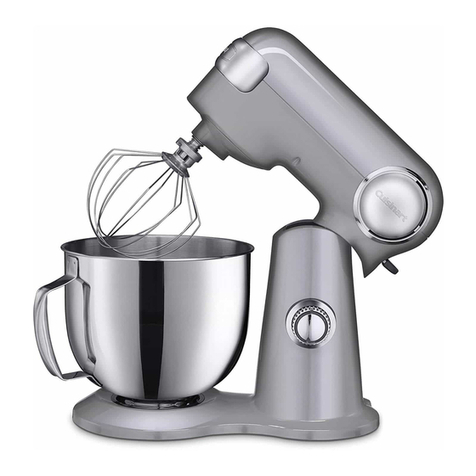
Cuisinart
Cuisinart Precision Master SM-50 Series INSTRUCTION AND RECIPE BOOKLET
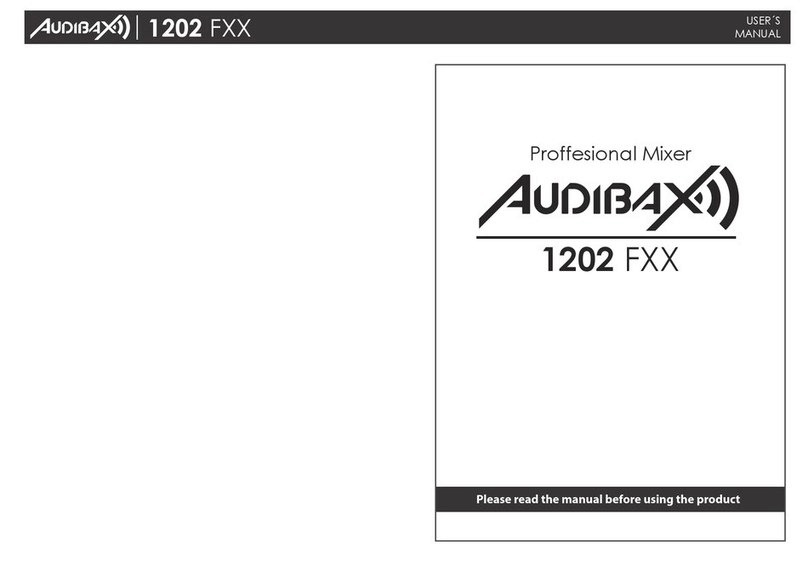
Audibax
Audibax 1202 FXX user manual

IXOM
IXOM AP4000 Operation & maintenance manual

KitchenAid
KitchenAid 5KSMC895ECA0 instructions

Varimixer
Varimixer W20 F Spare part and operation manual

Sony
Sony MCX-500 Update guide

METRO PROFESSIONAL
METRO PROFESSIONAL Makro professional GPM1020P instruction manual
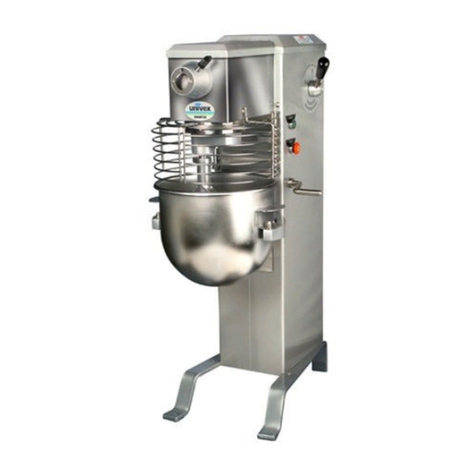
Univex
Univex Swing Ring Series Maintenance & parts manual

MIA
MIA Mix & Cut User instructions
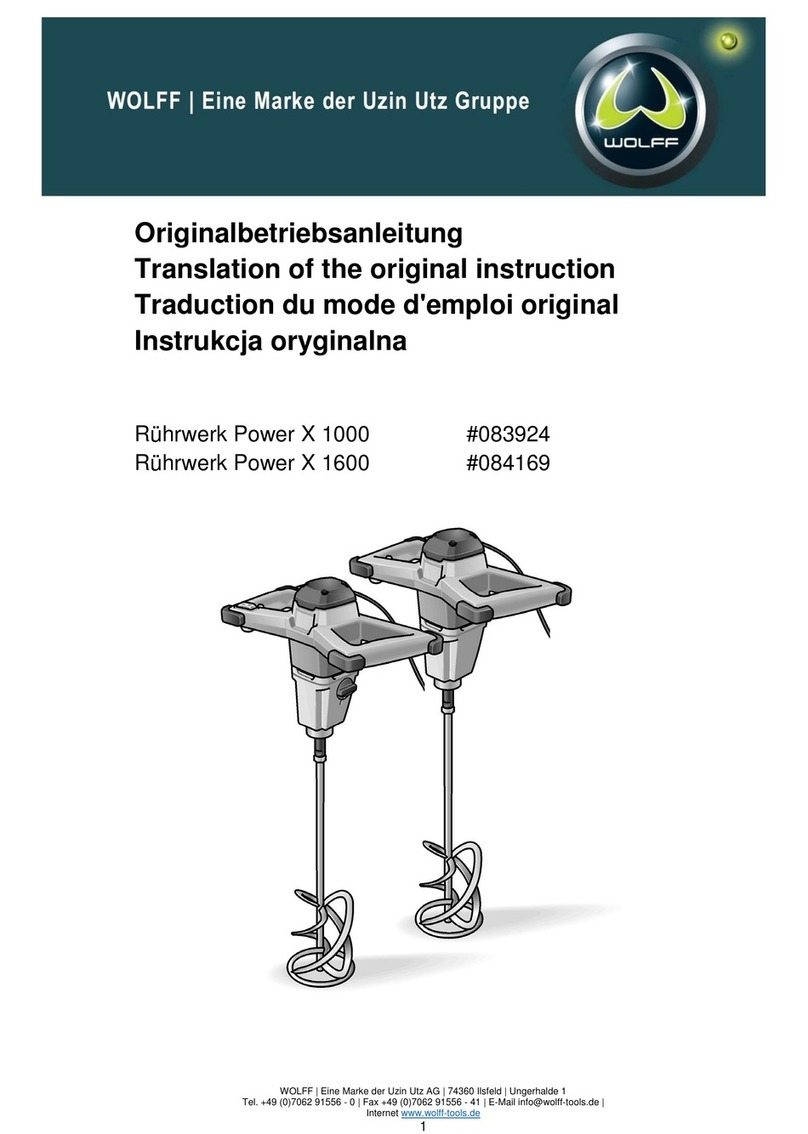
WOLFF
WOLFF Power X1000 Translation of the original instruction
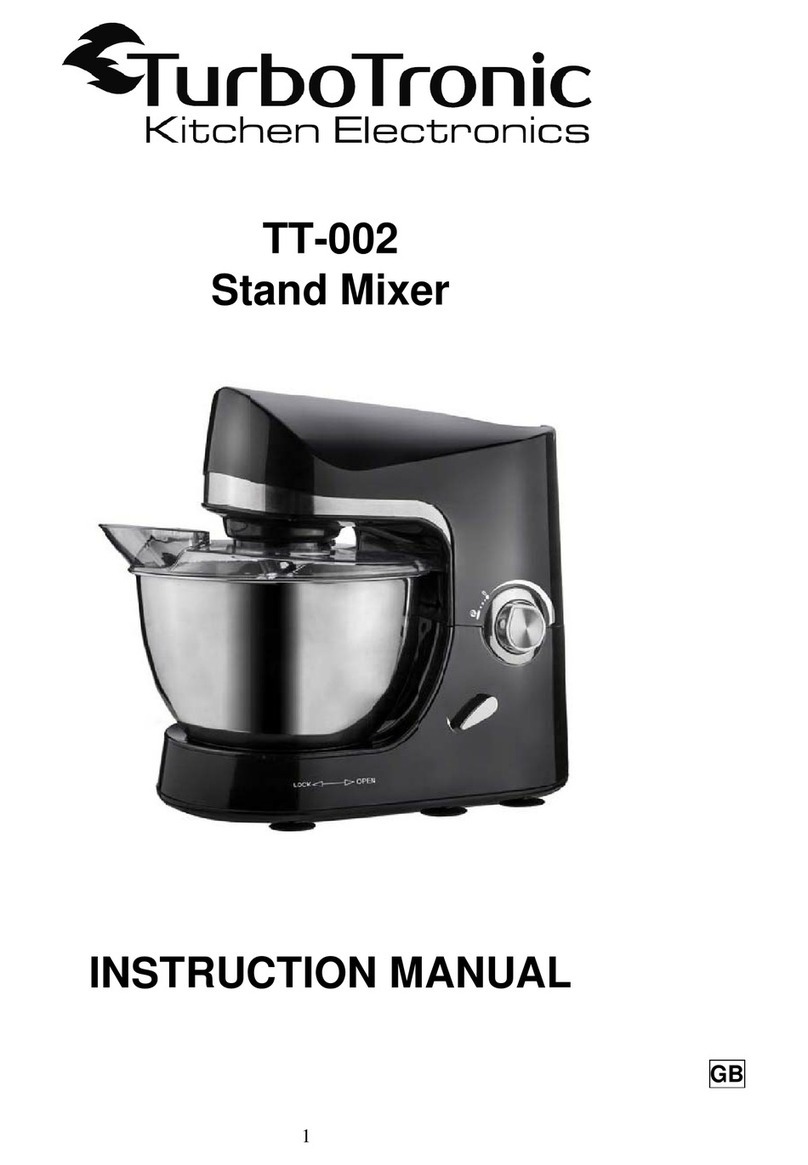
TurboTronic
TurboTronic TT-002 instruction manual
